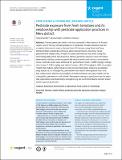| dc.description.abstract | Tomato pesticides health risk was assessed in Meru district of Arusha region, one of the key tomato producers in Tanzania. Tomato samples and consumption information were collected from 50 farmers using Food and Drug Administration standards and twice administered twenty-four hour recall questionnaire respectively. Analysis for pesticide residues was done using Gas Chromatography Mass Spectrometry. Dietary pesticide exposure was estimated deterministically by combining pesticide residue levels and tomato consumption levels. Pesticide levels were detected for; permethrin (mean, 5.2899 mg/kg), chlorpyrifos (mean, 7.5281 mg/kg) and ridomil (mean, 2,854.279 mg/kg) in 18% of samples. Health Risk Indices, determined as ratio of estimated daily intake to acceptable daily exposure, for chlorpyrifos, permethrin and ridomil were greater than one. This implies that, lifetime consumption of fresh tomatoes can pose health risk for chlorpyrifos, permethrin and ridomil. Awareness raising on good practices for pesticide application and food safety strengthening are recommended to protect public health against pesticides. | en_US |

